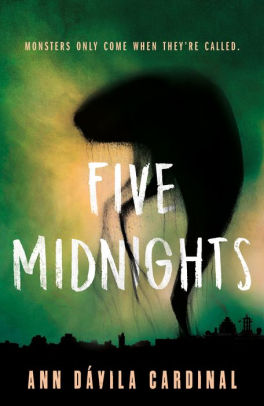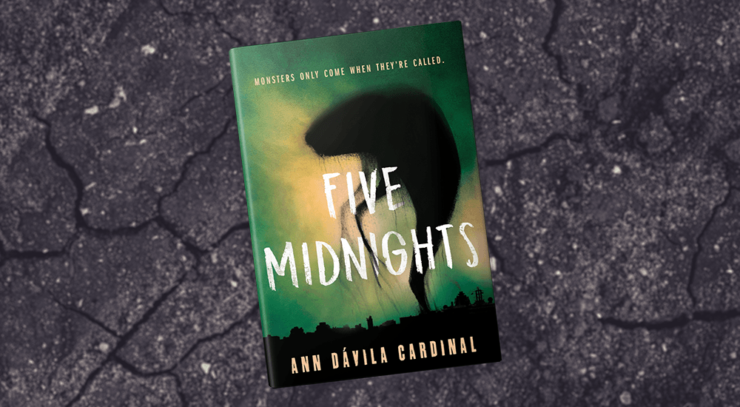Five Midnights by Ann Dávila Cardinal is a modern take on the El Cuco myth that is bound to be loved by many. With a narrative that’s well-paced and intriguing, the author builds a world that utilizes a story passed down through generations since the Spanish Colonization of Puerto Rico and Latin America.
Javier Utierre and Lupe Dávila are trying to find out who (or what) killed two boys in San Juan, and along the way uncover an old magic based on the aforementioned myth. As Lupe and Javier become embroiled in the chase for the murderer, their adventure grows more nebulous. The mystery introduces us to some colorful side-characters who give us pieces of the ultimate puzzle, such as Papi Gringo, one of Javier’s childhood friends who’s become a sort-of Bad Bunny personality, and Izzy, another one of Javier’s friends but also Lupe’s elusive cousin. All the characters add to the story’s sense that everyone knows or is connected to each other, which is essential when writing about Puerto Rico; there’s always a feeling like you know somebody who knows somebody within Puerto Rican culture.
The adventure and themes of belonging might resonate with those who’ve desired to see a book set in Puerto Rico, with Puerto Rican characters, written by a Puerto Rican author, published by a mainstream American publisher for many years. I was one of those, seeing as most of the YA with Puerto Rican characters focuses on the diasporic Puerto Rican experience in the US.
You know those puzzles where you have two images that look the same but have something missing, but you can’t seem to find what it is that’s missing? That was what reading through the beginning of Five Midnights was like for me. Reading about characters prancing about the Metro area of Puerto Rico in search of a creature that may or may not exist made me have to step back. I had to sort of dissociate the fact that I was reading about my home in a way that I never had before.
Despite this disconnection, the urgency of the narrative is clear, as Lupe and Javier try to figure out what is causing boys to die in gruesome ways on their birthdays. I found myself glued to the book, trying to figure out what was going on in the same way the main characters did. Dávila Cardinal masterfully gives just enough information to the reader, in the same way as the adults in the story and Puerto Rican “grown-ups” do to younger people, for them to try to decipher this puzzle she’s laid out. A mysterious, shadowy figure is on the hunting down Puerto Rican boys, bringing to life the old tale parents used to threaten their children to make them behave well. The murdered boys in the story weren’t saints, but they were still young when they were killed, just minutes before they could turn 18.
There’s a running theme of lost innocence, which is often seen a lot among Puerto Rican youth. In Five Midnights, Javier is the one who struggles with the concept of innocence the most. Javier comes from an affluent family and is a recovering addict. He doesn’t believe he’s innocent due to his drug usage from a very young age and deals with an overwhelming guilt, due to two of his childhood friends dying. However, his greatest moments stem from this guilt. He realizes that he took his youth and innocence for granted, and that he hurt the people closest to him without caring for the consequences. His privilege puts a strain on his recovery, but he manages to move forward in his life.
Another theme in the book is that of belonging. Lupe is a biracial, white Puerto Rican raised in Vermont who gets sent to Puerto Rico to spend the summer with her uncle, the Chief of Police in charge of the murder investigation. Lupe spends most of the book trying to figure out what has happened to these boys, painting her as an idealistic amateur sleuth. However, she spends more time arguing with people over the fact that she’s white, and therefore a “gringa” who doesn’t belong according to isleños. I don’t have a problem with the story centering on a white Puerto Rican, especially since the author herself is a white Puerto Rican, and not many people cover the topic of biracial Puerto Ricans in literature. Even so, this topic is dealt with in a way that I found thought-provoking.
Buy the Book


Five Midnights
What I struggled with was Lupe’s desire to see “the real Puerto Rico.” What does it mean to see “the real Puerto Rico?” And why does Lupe focus so much on the fact that she’s a white Puerto Rican? What does it mean to be Puerto Rican? At one point, Javier even says “he felt superior in his Puerto Ricaness compared to [Lupe]. His roots dug deep in the magical Caribbean soil.” The conflation of land as belonging, without questioning what it took for this land to become what it is now and erasing the many deaths of indigenous people and the history of slavery, and idealize it into “magical Caribbean soil,” is exotifying the land that we walk on. The fetishization of this specific brand of nationalism that only cares about whether or not one is Puerto Rican enough, rather than focusing on the history of colonization and oppression and the desire for liberation from the American imperialist state is ever-present in the book.
The question of Puerto Rican identity is one that is challenged over and over among the characters in the book to the point of detracting from the murders happening around them. At one point, Lupe thinks: “She was half Puerto Rican! Half! If only she actually looked it. When she was little she used to rub her hands over her freckle-covered, pale arms as if that would spread the freckles around and give her skin the same warm color as her father’s.” The onus of Brown Puerto Ricans having to assuage a white Puerto Rican’s safety in her identity is tiresome. Yes, they are Puerto Ricans. What are they doing with the privilege that their white skin brings them? Why is it up to us to reiterate that they deserve to be called Puerto Ricans?
I didn’t care much for that discussion, especially when most of the time it came at the cost of exploiting the image of the Puerto Rican woman in the form of the attacks toward a character named Marisol. Marisol is seen by the other characters as a “crazy” woman, when in fact she’s just as, perhaps even more so, traumatized as Javier and his friends. She’s lost her brother and her home to American finance vultures, and has been institutionalized. She gets into fights, including fighting with Lupe for what seems like no actual reason other than the fact that she’s white and we need to see Lupe as a victim. It’s also mentioned that Marisol is an independentista, which means that she believes in Puerto Rican independence. She’s rightfully angry about her circumstances, and I tended to side more with her, so when the final twist happened at the end I wasn’t all that surprised that she wasn’t the villain of the story; she was yet another victim of circumstance.
How something evil could be created with the intention of protection and love spoke to me. In the way that sometimes parental love can become twisted if they’re not careful, things can go wrong even when you have good intentions, which is a great summary of this story and my experience with the book.
This book truly had me torn between loving the injection of Puerto Ricans into the literary YA canon, and despising the fact that this was gonna be what people believe “the real Puerto Rico” is: drugs, murder, and villainization of Puerto Rican nationalism. “Bet these places aren’t in the tourists’ guides,” Lupe tells Javier as they drive around “the sketchier parts of the island.” This is what the real Puerto Rico is: crumbling infrastructure, a police force that doesn’t take femicide or intimate partner violence seriously, the taboo of mental health issues, the ghettoization of low-income households and communities, a government that doesn’t care for its constituents and only cares about pandering to the US and their vultures, colorism…
There are glimpses of it at times, mostly from Marisol’s perspective. But until we can move away from the image of Puerto Rico as a beautiful tropical island with delicious food that can be violent at times, I don’t think I’ll be completely satisfied in the literature that takes place on the island.
Five Midnights is available from Tor Teen.
Adriana M. Martínez Figueroa (@boricuareads on social media) is a bisexual Puerto Rican writer. She holds a B.A. from Iowa State University in Women and Gender Studies with a minor in US Latinx Studies. Her words can be found on her WordPress blog (Boricua Reads) as well as inQluded and the forthcoming anthology Boricua en la Luna.










